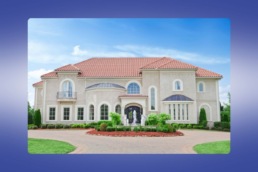Homeowners Insurance: Is a Standard Policy Enough for Your Bigger Home
In the U.S., homes now cost over $350,000 on average across the country. One of the most important obligations you have as a homeowner is choosing the right homeowners insurance.
However, not everybody understands whether a standard home insurance policy provides enough protection to cover a larger home. Let’s take a closer look to see the coverage amounts traditional home insurance policies can offer and compare that to the insurance needs larger homes may have.
What Do Standard Policies Cover?
Standard homeowners insurance policies cover damage to your home caused by fires, windstorms, hail, and other weather-related events. Coverage also includes theft and vandalism of the property plus personal belongings like furniture and clothing.
Additionally, standard policies provide liability coverage if someone is injured on your property or if you’re held liable for another person’s injury or property damage.
You may be able to purchase additional coverage depending on the risk factors associated with where you live.
What About a Larger Home?
For homeowners who have more expensive homes, especially those in higher-risk hurricane or earthquake-prone regions, additional coverage may be needed.
The good news is that most insurance companies offer extended coverage for large homes that protect against damage from things like flooding and earthquakes. They may also provide additional coverage for items like expensive jewelry and other valuables. Be sure that you keep this in mind when moving forward.
Note that your policy may still not be sufficient fully cover your needs.
How Do I Know if I Have Enough Coverage?
Put simply, you will need to determine the financial limit of your policy and compare it to the value of your home. For example, let’s assume that a standard policy from a particular insurance provider caps at $500,000. However, if your home is valued at $750,000, the policy’s coverage limit won’t be enough.
This could leave you vulnerable to potential losses if an incident happens that exceeds the $500,000 limit. Unfortunately, scenarios like this aren’t impossible.
All it takes is a single flood, hurricane, tornado, fire, etc. to put you in financial ruin. The good news is that there are policies out there that can accommodate scenarios like this.
What Can Impact Home Rebuilding Costs?
In the event of a tragedy, you may need to repair or even completely rebuild your home. Rebuilding costs are not always the same as the purchase price of your home.
Depending on where you live, certain building codes and permit requirements can impact the cost of rebuilding after a catastrophic event. Other factors include the style of your home, the number of rooms, and the type of materials used.
Cost is also affected by the current market price of labor and materials. It will also vary from location to location. Rebuilding a high-value home in California, for example, will likely cost more than doing so in Montana. For this reason, it’s always recommended that you have coverage that surpasses the value of your home.
What Type of Coverage Is Available For High-value Homes?
For larger homes, some insurance providers may offer a separate policy for high-value homes.
This type of policy could include additional coverage for items like pools and spas, guesthouses, landscaping, fine art collections, etc. Your agent can help you determine if this type of policy is necessary for your home based on the value of your home, its features, and the type of coverage you need.
How Does Inflation Factor Into Coverage?
A primary concern of those with high-value homes is how inflation will impact labor and material costs over time. To clarify, let’s assume that your home is worth $750,000 and you have $800,000 worth of coverage.
Seven years after you purchase your policy, however, a storm requires you to rebuild your home. Due to inflation, the total cost to rebuild your home is now $1 million.
The good news is that most insurance companies offer inflation coverage protection. This can usually be added to your policy at an additional cost and ensures that you will have enough money to rebuild in the event of a tragedy, even after accounting for inflation.
What Should I Look For in an Insurance Provider?
Not all companies will be able to meet your needs. So, you shouldn’t always work with the first person you find.
When looking for an insurance provider, make sure they’re reliable and have a track record of paying claims in a timely manner. You should also inquire about their customer service and the level of coverage they offer for high-value homes.
Ask about any discounts that may be available to you. Many insurance companies offer special discounts for things like alarm systems, smoke detectors, and other safety precautions. In some cases, these could prove to be substantial.
Be sure to shop around for different policies. Chances are that you can save a significant amount of money by having a handful of options to choose from.
Finally, find out if they offer any additional services, such as appraisals of your home or valuables. These can help you update your coverage limits and make sure that you are adequately protected in the event of an emergency.
You Shouldn’t Overlook Homeowners Insurance
Choosing the right homeowners insurance comes with plenty of benefits that you can’t neglect. Consider the above info so that you can make the decision that is best for you.
Looking for more information about what we can do? Reach out to us today to see how we can help.
